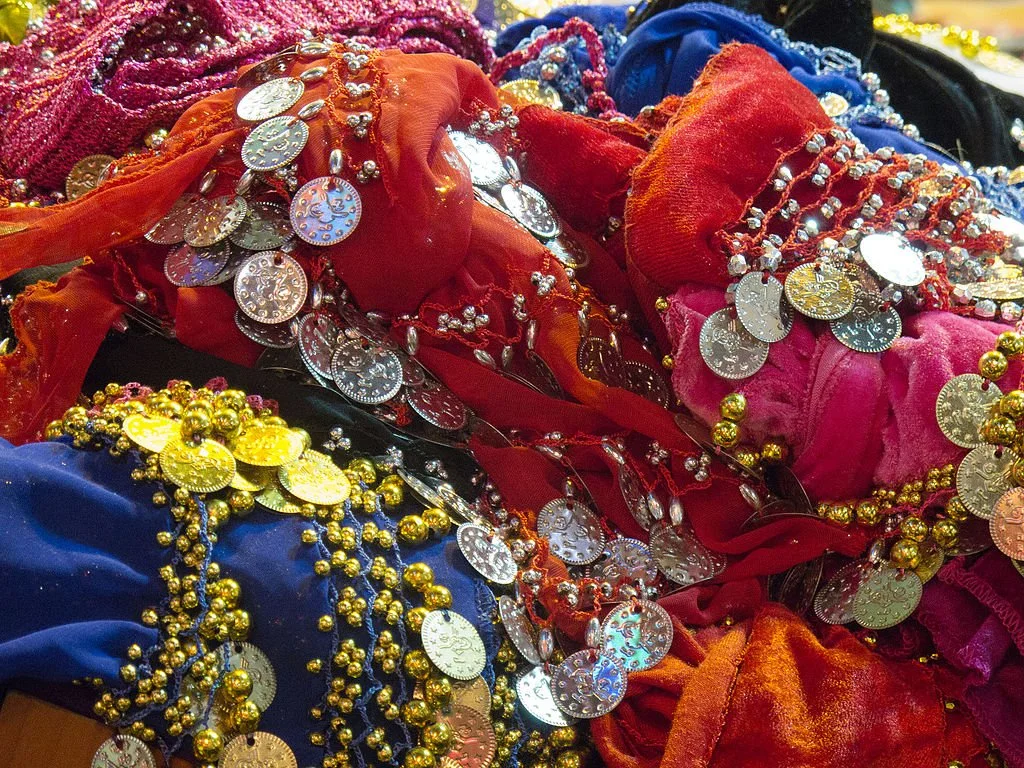The Gig Economy of Belly Dance in Philadelphia
Razan Idris
In 1959, The Middle East opened as the first restaurant serving Arab cuisine in Philadelphia — but that’s not all it was known for. First located in South Philadelphia before moving to Old City, the restaurant advertised itself as Philadelphia’s sole “belly dance emporium”. Since then, belly dance has grown in popularity within the United States, with many Philadelphia-area dance centers now offering “belly dance fitness” classes. But as more Mediterranean restaurants draw in customers with the promise of live belly dance, belly dancers struggle to perform in a precarious and racialized gig work economy.
Philadelphia-area belly dancers - who are demanded to perform "Middle Eastern authenticity" for the restaurant - often come from non-SWANA backgrounds. One of those performers, Selene Rose, a Black belly dancer who has been performing since 2005, tells Al-Bustan, “My first teacher was a white belly dancer who I met at a friend’s mother’s Christmas party when I was younger.” After moving to Philadelphia as a grad student, Selene got involved with the University of Pennsylvania’s Yalla dance troupe before studying with Habiba, whose studio specializes in teaching “Middle Eastern movement techniques”.
Eventually, Selene says, “I was good enough to begin getting paid by restaurants.” But it turns out that SWANA restaurant owners are often looking for a certain type of belly dancer: Light-skinned and slender. “I’ve heard numerous stories from other black dancers about showing up at a gig and being told to go home,” Selene says frankly. “This one time I went to a performance wearing my natural hair, the owner made it one of the worst gigs of my life.”
Photo Credit: Brian Jeffery Beggerly
This anti-Blackness - where a folk dance becomes seen as only for a certain body when professionalized - reflects a broader regional history in SWANA of equating professional dancers with “modern women” who are light skin and thin. But within Philadelphia’s belly dancing communities, anti-Blackness is further compounded by the United States’ own racial histories. In the 1970s, white women in the second-wave feminist movement were attracted to belly dancing as a form of self-empowerment, but, as belly dancer and anthropologist Jennifer Lynn Haynes-Clark notes, these women often disconnected “between the modern practice of belly dance and the lives of modern women from the East”.
A casual Google of “belly dance” in the Philadelphia area usually reveals white female performers who, despite their use of Arabic stage names, present their art as unrelated to the contemporary SWANA region. In 2014, Palestinian writer Randa Jarrar, who is based in the Philadelphia area, critiqued the whiteness of American belly dancing communities, writing in Salon, “The most disturbing thing is when these women take up Arabic performance names -- Suzy McCue becomes Samirah Layali. This name and others like it make no sense in Arabic. This, in my estimation, completes the brownface Orientalist façade.”
Jarrar’s critiques are also noticed by Selene, who tells Al-Bustan, “The belly dance community in the United States has only just begun having conversations about supporting native dancers as much as they can.” However, the problem is not limited to the United States’ borders. As Selene notes, “Even the dancers performing professionally in Cairo are overwhelmingly white eastern European women.”
“‘The American audience’s mindset is often ‘I’m tipping you and so now I get to put my hands on you…’”
Meesha Tayoun, who has been belly dancing professionally in Philadelphia for years, explains, “There is the stigma in the Middle Eastern and Arab world, where we want to see a talented skillful beautiful dancer perform, but we don’t bring a raqasa home to mom.” Similarly, Algerian rai dancer Esraa Warda, who has done dance workshops with al-Bustan, told the New York Times that women’s folk dances are often considered unacceptable for the stage by home audiences. In Egypt - home of raqs sharqi - professional belly dance has become associated with sex work, and Egyptian stars have largely been replaced by foreigners who also struggle to find gigs.
When dancers do find restaurant work in Philadelphia, they are often underpaid and sexual harassment is routine. Dressing in pantries, surrounded by restaurant workers, and with no bouncer, the dancers have no protection from their audience. “The American audience’s mindset is often ‘I’m tipping you and so now I get to put my hands on you,’”explains Selene. “So during performances, people will touch you, they’ll even stuff food in your mouth, and you can’t exit the floor because the restaurant owners are paying you to be an attraction.”
Despite her harsher experiences with belly dance gig work, Selene believes that the belly dance community is slowly but surely improving. “It’s a struggle but people are really trying to be aware - the pandemic helped people learn to use Zoom to connect with belly dancers in Egypt.” And as a dancer, Selene loves connecting with families or with parties of Egyptian and Lebanese people. She tells Al-Bustan, “They understand the music, the dance, they tip politely, they dance with you - and I love dancing with little kids too. Let’s all be like that!”
Razan Idris is a Sudanese-American PhD candidate in History at the University of Pennsylvania and the curator of the #SudanSyllabus, working on a project tentatively titled The Colors of the Earth: Blackness in 1930s Egypt.


